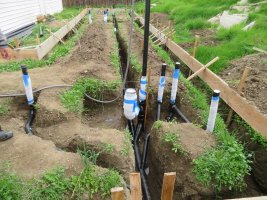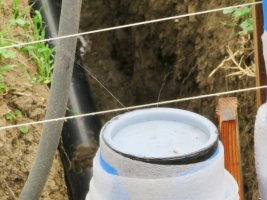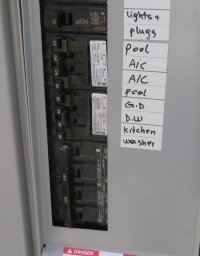-
Welcome to The Building Code Forum
Your premier resource for building code knowledge.
This forum remains free to the public thanks to the generous support of our Sawhorse Members and Corporate Sponsors. Their contributions help keep this community thriving and accessible.
Want enhanced access to expert discussions and exclusive features? Learn more about the benefits here.
Ready to upgrade? Log in and upgrade now.
You are using an out of date browser. It may not display this or other websites correctly.
You should upgrade or use an alternative browser.
You should upgrade or use an alternative browser.
An average day
- Thread starter ICE
- Start date
tmurray
SAWHORSE
Are they placing the slab on the top soil?
It's so weird to see construction there. So different from here with our 4' frost depth.
It's so weird to see construction there. So different from here with our 4' frost depth.
ADAguy
REGISTERED
No cover too?
The job is a re-roof. I was there or the final inspection. So I have to verify the smoke and CO alarms.

The dwelling is occupied but nobody was there. I called the phone number on the note to tell him that I do not enter occupied buildings without an escort. No answer....turns out to be the contractor's voice mail.

The dwelling is occupied but nobody was there. I called the phone number on the note to tell him that I do not enter occupied buildings without an escort. No answer....turns out to be the contractor's voice mail.
Last edited:
The grass will be removed for the footing inspection.Are they placing the slab on the top soil?
It's so weird to see construction there. So different from here with our 4' frost depth.
2' deep here is the norm.
How's that solar array meet Calfire perimeter requirement for rake to panel clearance?
I didn’t inspect that installation. I’ve seen more than a few carports that have an array for a roof. Would firemen get on the roof of a burning carport?
Can you ... or someone ... explain whats going on with the breakers in that picture. Looks like groups of 4 ganged together.On a service upgrade do you always require GFCI protection for the pool pump motor?
I am more curious about the 30 amp circuits.
Would firemen get on the roof of a burning carport?
Probably not! No reason to be on a carport roof.
Wasn't sure what type of structure it was.
mark handler
SAWHORSE
We cannot see the entire roof, sometimes panels to edge are permittableHow's that solar array meet Calfire perimeter requirement for rake to panel clearance?
Cal Fire Solar Photovoltaic Installation Guideline
https://www.fsec.ucf.edu/en/education/southeast_training_network/Background on CA PV Installation Guide.pdf
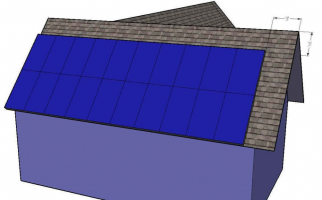
mark handler
SAWHORSE
Pool pump motors require GFCI protection. ... According to 680.22(B), so yes i would hope my inspectors would catch that.
mark handler
SAWHORSE
Does that Labling Meet Current Code?
Pool pump motors require GFCI protection. ... According to 680.22(B), so yes i would hope my inspectors would catch that.
In as much as I have to write that correction every time there is a pool with a service upgrade....I'm certain that few inspectors require the GFCI.
I am not exaggerating about the "every time".
The job is a service upgrade. This is the water main. The contractor is an engineering firm that has a C-10 license. For everybody not in California, a C-10 is an electrical contractor and please stay where you are. Thanks for that.
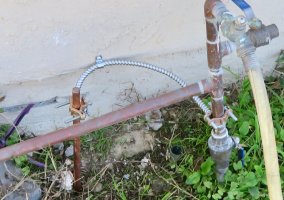
Notice the clamp that secures the jumper to the wall. The work is completely wrong and completely right.

Why do they think that the armor can be in the dirt?
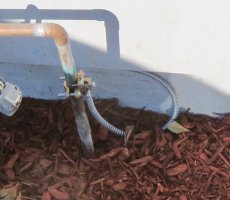
These pictures were taken on the same day....so I had at least three service upgrades on that day. I am just one of more than 1000 California inspectors. Hundreds are done every day and dozens are done by professional electricians.

Notice the clamp that secures the jumper to the wall. The work is completely wrong and completely right.

Why do they think that the armor can be in the dirt?

These pictures were taken on the same day....so I had at least three service upgrades on that day. I am just one of more than 1000 California inspectors. Hundreds are done every day and dozens are done by professional electricians.
Last edited:
The plumbing company is tied in with a couple of retailers so they do plenty of water heaters. They almost always up-sell with the expansion tank. It's a real money maker.
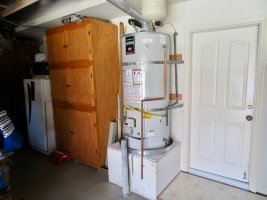
The installation instructions: (http://backstop.net/pdfdocs/BackStop Instructions.pdf) state that the tank should be 18" away from the heater with the tank vertical and the pipe that it's attached to, supported. There is a an air valve on the bottom for checking the charge. Or as in this case, not.
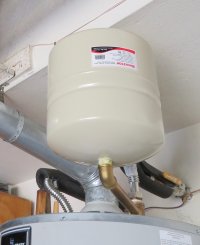
This is a rarity.
This is confusing in that the reason it is rare has to do with the placement of the valve which is usually attached to the end of the hard pipe with the connector screwed to it. The sediment trap is installed correctly and that is not so rare. I'd say about 50/50 on the trap.
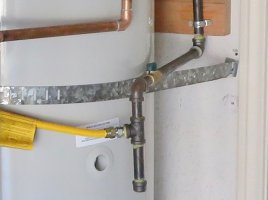

The installation instructions: (http://backstop.net/pdfdocs/BackStop Instructions.pdf) state that the tank should be 18" away from the heater with the tank vertical and the pipe that it's attached to, supported. There is a an air valve on the bottom for checking the charge. Or as in this case, not.

This is a rarity.
This is confusing in that the reason it is rare has to do with the placement of the valve which is usually attached to the end of the hard pipe with the connector screwed to it. The sediment trap is installed correctly and that is not so rare. I'd say about 50/50 on the trap.

Last edited:
jar546
CBO
At least they have a deep sediment trap
This is typical:
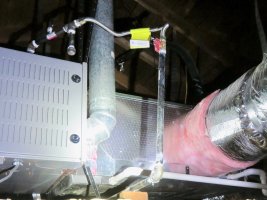
Look at the vertical segment of pipe. It seems to me that it should be secured from acting as a lever and either tightening or loosening the upstream pipe fittings. And that's what I told them. What is bothersome is that I had to tell them at all. This type of error tells me that the worker had no training on gas pipe. None. This mistake has got to be on the first page.

Look at the vertical segment of pipe. It seems to me that it should be secured from acting as a lever and either tightening or loosening the upstream pipe fittings. And that's what I told them. What is bothersome is that I had to tell them at all. This type of error tells me that the worker had no training on gas pipe. None. This mistake has got to be on the first page.
Last edited:
Post #3912
Pic #1, No anti-siphon device on the sillcock requirement in CA? Is it possible that the valve was installed prior to code requirement?
Pic #2, Ground rod sticking up grade, preferred it be below grade at inspection but visible. If the armor wasn't touching the earth would you consider that a daisy chain grounding system and allow?
Pic #3, I think the code allows the ground wire below the sidings edge without conduit protection. Here in the mid-west, a house service waterline can't be exposed like that because of freezing.
Post 3913
Pic #2, Flue pipe needs 6-inch clearance from combustibles and flue fasteners?
Post 3915, That sediment trap makes no sense in that location, would it make sense to replace the lower elbow with a tee and install the leg at that location? You got your pipe dope for sure!
Pic #1, No anti-siphon device on the sillcock requirement in CA? Is it possible that the valve was installed prior to code requirement?
Pic #2, Ground rod sticking up grade, preferred it be below grade at inspection but visible. If the armor wasn't touching the earth would you consider that a daisy chain grounding system and allow?
Pic #3, I think the code allows the ground wire below the sidings edge without conduit protection. Here in the mid-west, a house service waterline can't be exposed like that because of freezing.
Post 3913
Pic #2, Flue pipe needs 6-inch clearance from combustibles and flue fasteners?
Post 3915, That sediment trap makes no sense in that location, would it make sense to replace the lower elbow with a tee and install the leg at that location? You got your pipe dope for sure!
Post #3912
Pic #1, No anti-siphon device on the sillcock requirement in CA? Is it possible that the valve was installed prior to code requirement?
Answer 1. Ca does require an anti siphon device. I have never written the correction.
Pic #2, Ground rod sticking up grade, preferred it be below grade at inspection but visible. If the armor wasn't touching the earth would you consider that a daisy chain grounding system and allow?
Answer 2. 10' rod....or so they say. 6" from 8' is not worth the grief. I don't know what you mean by daisy chain.
Pic #3, I think the code allows the ground wire below the sidings edge without conduit protection. Here in the mid-west, a house service waterline can't be exposed like that because of freezing.
Answer 3. That is true enough but when the conductor spans between the house and the rod it is exposed to physical damage. Beyond that, it is a west coast thing to always have cable armor protecting the GEC.
Post 3913
Pic #2, Flue pipe needs 6-inch clearance from combustibles and flue fasteners?
Answer post 3913. Yes.
Post 3915, That sediment trap makes no sense in that location, would it make sense to replace the lower elbow with a tee and install the leg at that location? You got your pipe dope for sure!
Answer post 3915. So now you expect things to make sense? Do you have a code section for that?
Pic #1, No anti-siphon device on the sillcock requirement in CA? Is it possible that the valve was installed prior to code requirement?
Answer 1. Ca does require an anti siphon device. I have never written the correction.
Pic #2, Ground rod sticking up grade, preferred it be below grade at inspection but visible. If the armor wasn't touching the earth would you consider that a daisy chain grounding system and allow?
Answer 2. 10' rod....or so they say. 6" from 8' is not worth the grief. I don't know what you mean by daisy chain.
Pic #3, I think the code allows the ground wire below the sidings edge without conduit protection. Here in the mid-west, a house service waterline can't be exposed like that because of freezing.
Answer 3. That is true enough but when the conductor spans between the house and the rod it is exposed to physical damage. Beyond that, it is a west coast thing to always have cable armor protecting the GEC.
Post 3913
Pic #2, Flue pipe needs 6-inch clearance from combustibles and flue fasteners?
Answer post 3913. Yes.
Post 3915, That sediment trap makes no sense in that location, would it make sense to replace the lower elbow with a tee and install the leg at that location? You got your pipe dope for sure!
Answer post 3915. So now you expect things to make sense? Do you have a code section for that?

